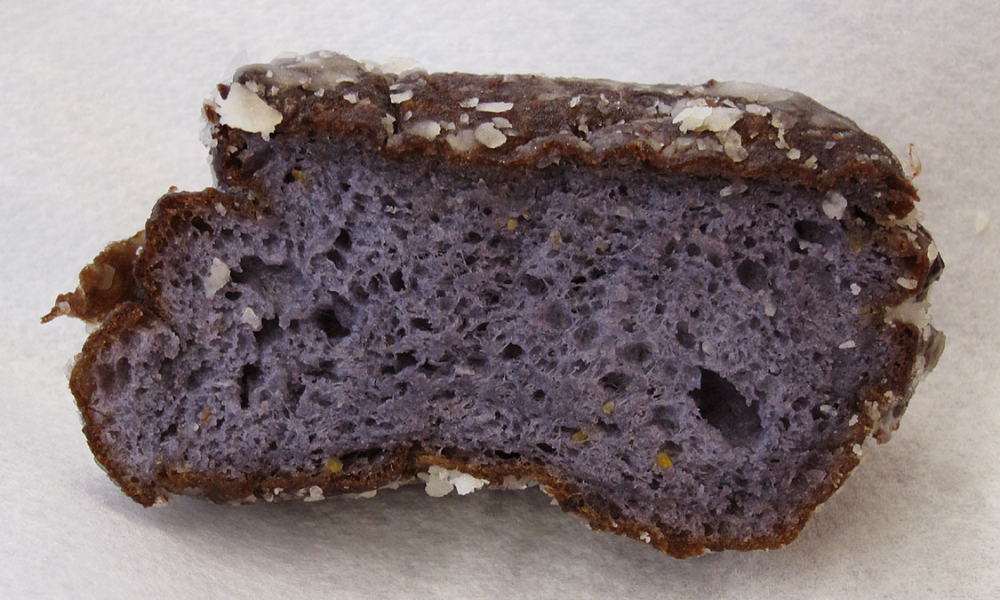Poi is a traditional staple food of Native Hawaiian cuisine. It is made from the underground corm (or root) of the taro plant, which is known as kalo in Hawaiian. Taro is a starchy tuber that has been cultivated in Hawaii for centuries and holds great cultural significance.
It is typically eaten as a side dish or condiment, served alongside other Hawaiian dishes like kalua pork, lomi salmon, or laulau. It is commonly enjoyed by scooping it up with two or three fingers, rather than using utensils.
Poi is often described as having a unique flavour and texture. It has a slightly sour or tangy taste due to the natural fermentation that occurs during the preparation process. The surface can be smooth and creamy or slightly lumpy, depending on personal preference and the specific method of preparation.
In addition to being a food source, poi holds cultural and historical significance for the Hawaiian people. It has been a staple in the Hawaiian diet for generations and is often associated with traditions, gatherings, and celebrations. Poi is considered a symbol of Hawaiian identity and is an important part of the cultural heritage of the islands.
How to Make Poi?
To make poi, the cooked taro root is blended or pounded until it becomes a thick, smooth paste. The consistency can vary, ranging from thick and sticky to thinner and more liquid-like.
It has a distinctive purple-grey colour, which comes from the natural pigments in the taro root. To make poi, a traditional Hawaiian dish made from taro root, you will need the following ingredients and equipment:
Ingredients:
- Taro root (look for firm and healthy taro roots)
- Water
Equipment:
- Large pot
- Blender or food processor
- Cheesecloth or fine-mesh strainer
Here’s a step-by-step guide:
- Peel and clean the taro root: Remove the outer skin of the taro root. Rinse the taro root under cold water to remove any dirt or debris.
- Cut the taro root: Cut it into small, uniform pieces. This will help with the cooking process.
- Boil the taro root: Fill a large pot with water and bring it to a boil. Add the taro root pieces to the boiling water and cook them until they are soft and easily pierced with a fork. The cooking time will vary depending on the size of the taro root pieces, but it usually takes about 20-30 minutes.
- Drain the taro root: Once the taro root is cooked, remove it from the pot and drain the water. Allow the taro root to cool slightly before proceeding to the next step.
- Blend the taro root: Place the cooked taro root pieces in a blender or food processor and blend until smooth. You may need to add a little bit of water to achieve the desired consistency. Blend for a few minutes to ensure a smooth and creamy texture.
- Strain the mixture: Place a cheesecloth or fine-mesh strainer over a bowl or large container. Pour the blended taro root mixture onto the cheesecloth or strainer, allowing the liquid to strain through. Use a spatula or the back of a spoon to press down on the mixture and extract as much liquid as possible. The liquid is poi, and the remaining solid is called pa’i’ai.
- Serve and enjoy: Transfer the strained poi into a serving bowl. It can be enjoyed at room temperature or chilled. You can serve it as a side dish or dip, or use it as a base for other Hawaiian dishes.
What Does Poi Taste Like?
- Earthy: It has an earthy undertone that comes from the taro root itself. It has a natural, plant-based flavor that is reminiscent of the root vegetable it is made from.
- Tangy: Poi undergoes a natural fermentation process, which gives it a slight tanginess. This tanginess adds a subtle sourness to the flavor profile.
- Mildly Sweet: Some varieties of taro have a naturally sweet taste, and this sweetness can come through in the poi. However, the sweetness is typically not overpowering and is more of a subtle note in the overall flavor.
- Nutty: It can sometimes have a hint of nuttiness in its taste. This nutty flavor can be attributed to the taro root and its natural characteristics.
- Mellow: Poi has a mellow and smooth taste overall. It does not have any sharp or intense flavors, but rather a gentle and soothing quality that is often enjoyed as part of a meal.
It is important to note that individual taste preferences can vary, and some people may perceive the flavor of poi differently. Some individuals may find the taste to be more enjoyable when paired with other Hawaiian dishes or used as a base for sauces and dressings. Exploring the flavor is an experience that is best done firsthand, as words can only convey a limited description of its unique taste.
How to Eat Poi?
Poi is traditionally eaten using two or three fingers rather than utensils. Here are some common ways to eat it:
- Scooping Method: Dip your fingers into the bowl of poi and use them to scoop up a small portion of it. Lift your hand to your mouth and enjoy it directly from your fingers. Repeat this process until you’ve eaten the desired amount.
- Two-Finger Method: Using your thumb and index finger, pinch a small amount of poi from the bowl. Bring your hand to your mouth and gently slide your thumb and finger apart, releasing it into your mouth.
- Mixing Method: Poi can also be mixed with other dishes or used as a condiment. It can be added to other Hawaiian foods like kalua pork, lomi salmon, or laulau to enhance the flavors. Simply scoop up a bit of poi with your fingers and combine it with the other food on your plate before taking a bite.
Remember, it can have a unique texture, ranging from thick and sticky to more liquid-like. Adjust your scooping technique based on the consistency you have.
Is Poi Good For Health?
Poi can be a nutritious food choice with several health benefits. Here are some reasons why poi can be considered good for health:
- Nutrient-Rich: Poi is made from taro root, which is a good source of essential nutrients such as dietary fiber, potassium, magnesium, and vitamins C and E. These nutrients are important for maintaining overall health and supporting various bodily functions.
- Complex Carbohydrates: Taro root, the main ingredient in poi, is a complex carbohydrate that provides a steady release of energy. It can help sustain energy levels and keep you feeling fuller for longer, which can be beneficial for maintaining a healthy weight and managing hunger.
- Dietary Fiber: Poi contains dietary fiber, which is essential for a healthy digestive system. Fibre promotes regular bowel movements, helps maintain bowel health, and can contribute to feelings of satiety.
- Gluten-Free: Poi is naturally gluten-free, making it a suitable option for individuals with gluten sensitivities or celiac disease.
- Antioxidants: Taro root contains antioxidants, such as polyphenols, which help protect the body against cellular damage caused by harmful molecules called free radicals. Antioxidants are associated with a reduced risk of chronic diseases like heart disease, certain cancers, and age-related macular degeneration.
How to Store Poi?
To properly store poi and maintain its freshness, follow these guidelines:
- Refrigeration: Poi should be stored in the refrigerator to maintain its quality and prevent spoilage. Transfer the poi into an airtight container or cover the original container with plastic wrap or a tight-fitting lid.
- Proper Temperature: Set your refrigerator to a temperature between 35°F and 40°F (1.7°C to 4.4°C). This temperature range helps slow the fermentation process and keeps the poi fresh for longer.
- Labeling: If you have multiple containers of poi or plan to store it for an extended period, it’s helpful to label the containers with the storage date. This will help you keep track of freshness and ensure you consume it within a reasonable timeframe.
- Consumption Timeframe: Poi is best consumed within 3 to 5 days of preparation. As time passes, the poi may continue to ferment, thicken, and develop a stronger tangy flavour. For the best taste and texture, try to consume it within this recommended timeframe.
- Freezing (optional): If you have a large amount of poi and don’t anticipate consuming it within a few days, you can freeze it to prolong its shelf life. Transfer the poi into a freezer-safe container or wrap it tightly with plastic wrap and place it in the freezer. Frozen poi can be stored for up to 6 months. To thaw, place the container in the refrigerator overnight or thaw it at room temperature. Stir well before serving, as the texture may change slightly after freezing.
Conclusion
In conclusion, poi is a traditional Hawaiian dish made from the taro root, known as kalo in Hawaiian. It is prepared by cooking the taro root and then blending or pounding it into a thick, smooth paste.
Poi has a unique purple-grey color and a slightly tangy flavor resulting from the natural fermentation process. It is typically served as a side dish or condiment and holds cultural significance in Hawaiian cuisine and traditions. Poi is not just a food but also a symbol of Hawaiian identity and a cherished part of the islands’ cultural heritage.



